|
|
|
|
January 2005
|
|
Contents:
|
|
|
Susan Sontag, writer, born 16th
January 1933, died in New York 28th December
2004.
Regarded as one of USA's leading
intellectuals her greatest literary impact
was as an essayist, with her 1964 study of
homosexual aesthetics 'Notes on Camp'
establishing her as a major new writer.
Calling herself an "obsessed moralist", she
was the author of 17 books and a lifelong
human rights activist. She wrote best-selling
historical novel 'The Volcano Lover' (1992)
and another historical novel 'In America'
(2000) won the National Book Award.
|
|
|
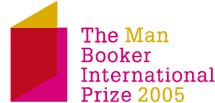 The Man Booker
International Prize
The Man Booker
International Prize
A major new literary prize is being launched, which
will extend the scope of the Man Booker Prize for
fiction internationally. The prize is worth £60,000 and
will be awarded in mid 2005.
The Man Booker International Prize will recognize one
writer for their achievement in fiction. The prize will
be awarded once every two years to a living author who
has published fiction either originally in English, or
generally available in translation in the English
language.
Nominations are invited from the public although there
is a rider that "it may not necessarily influence the
judges, but if you have a really good reason why
someone should win, let the world know about it". Names
can be submitted at
their website.
|
|
eBay 'Second Chance' scam
The Antiques Trade Gazette reports that the latest scam
on eBay is on high value sales where the underbidder is
contacted 'purportedly by the seller' with an offer to
buy, 'the winning bidder having pulled out' of the
sale.
On the occasion they report the underbidder at $4200
knew the winning bidder, had already discussed the sale
and knew that they would not have 'pulled out'. The
matter was reported to eBay who were slow in responding
but replied later:
"Any transaction that does not involve using the ‘Bid
now’ or ‘Buy it now’ buttons on eBay is considered an
off-site transaction. We reviewed your report and found
that although the message you received was made to
appear as if it had been sent by an eBay user, it was
not."
|
|
Fore-edge Paintings by
Stephen
Foster
Discovering a fore-edge painting is always a pleasant
surprise. When I first started my bookselling
apprenticeship, it was one of the first things I was
told to look out for (along with interesting
bookplates, and ephemera tucked into the books).
If you have not come across fore-edge paintings, let me
first explain what they are. If you are holding a
book in your hand, then the fore-edge is the long edge
you can flick through, or fan out. Fore-edge painting
refers to any painted decoration of this fore edge. The
artist slightly fans out this edge, it is secured or
held in a vice, and decorates it with a painted view,
or portrait or historical scene. In earlier examples,
the painting was applied, and then the fore edge was
gilded (gold leaf is applied). In later examples, a
book with an already gilded fore-edge - usually a fine
leather binding - has the painting applied after it is
bound. In both cases, when the book is returned to its
closed state, the painting is concealed by the gilding;
fan out the edges, and the painting reappears.
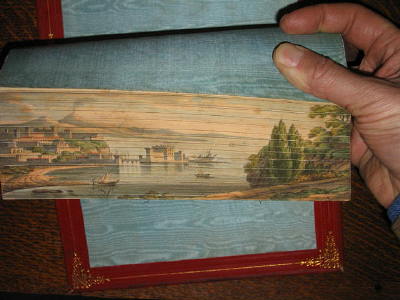
Here is a little movie file of some fore-edges being
fanned to reveal their paintings. You can view this 1MB
.mov file if you have the QuickTime plugin. It comes
courtesy of the
Horace W. Sturgis Library at Kenneshaw State
University, Georgia (USA) but we have copied it to our
server to save their bandwidth!
The Italian Renaissance is, as with many things, where
it all really started (although medieval examples
exist). Often quite simple, floral decorations,
heraldic designs or motifs, these were generally
painted directly onto the fore-edge rather than later
‘fanned’ edge, sometimes with a gold background. These
were not uncommon in 15th and 16th century Italy. But
the term is now largely used to refer to the British
examples of this art. Disappearing pictures start to
appear, as it were, on mid 17th century English bibles
and common prayer books. By the latter part of the 17th
century, very fine works were being produced.
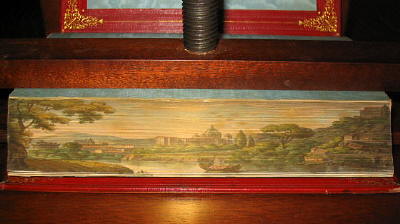
However, the pinnacle of this art was in the late 18th
century revival and popularisation of the art by the
bookbinders and booksellers Edwards of Halifax. They
produced exquisite paintings on the edges, as well as
beautiful ‘Etruscan calf’ and painted vellum bindings.
London Society was wowed by the beautiful volumes, and
the Edwards And Sons shop in Pall Mall is mentioned by
Fanny Burney (also known as Madame d'Arblay), the 18th
century London socialite who wrote an extensive diary
as well as various novels.
The practice of fore-edge painting became widespread,
and continued through the 19th and into the 20th
century. Demand has always outstripped supply, and this
meant that decorating the fore-edge continues to this
day. These later examples tend to be applied after the
book is bound and the fore-edge gilded, but they are
still beautiful and surprising things.
Themes vary, with landscapes, portraits, historical
subjects, sporting and erotic images all being used.
There are also ‘double’ or two-way paintings, with
views visible when the book is fanned either way. I
once saw a volume that showed mountaineers scaling a
peak, and both the top and bottom edge had also been
used to show the peak, and the base camp.
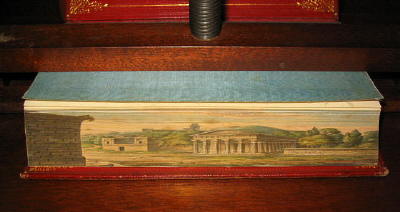
Original examples are very hard to find and a good
provenance will make these very expensive items. Late
19th and 20th century examples can be found for a few
hundred pounds, with the quality of both the binding
and image setting the price.
Where to find them? Well they could be found on
almost any book with a gilded fore-edge - poetry,
history, travel, classics, bibles are some to look out
for. There are many poor amateur examples, that can
disappoint, and many pleasing modern examples. So when
you see a bookseller picking up a leather bound book
and fanning the fore-edge, even though he’s not often
actually looking for one, he knows that if it’s there,
that is the way to reveal the secret.
Further examples of fore-edge paintings can be seen
at:
Horace W. Sturgis Library, Kenneshaw State University,
Georgia and
University of Florida Rare Book Collection
|
|
December Auction Round Up
First to Sotheby's, New York in early December and a manuscript copy the famous Christmas Poem, 'Twas the Night Before Christmas, inscribed by the author Clement Clarke Moore failed to find a buyer despite the appropriateness of the season, and a pre-sale estimate of US$2-300,000.
|
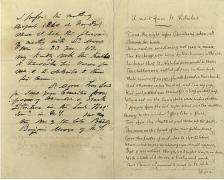
|
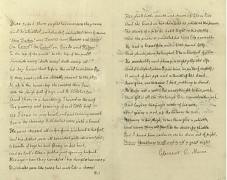
|
|
The
manuscript
of 'Twas
the Night
Before Christmas
|
The failure to find a buyer for such a desirable piece, the only manuscript copy in private hands, may rest in part on the fact that authorship of the poem, properly titled A Visit From St Nicholas, is disputed. The claims of the Livingstone family that their ancestor, Henry Livingstone Jr (1748 - 1828) was the real author were recently boosted in Donald Foster's Author Unknown: On The Trail of the Anonymous (Henry Holt, 2000).
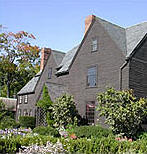 Not to be outdone, Christie's, New York sold the oldest known copy of Nathaniel Hawthorne's The Scarlet Letter for US$545,100 on 15th December, despite a pre-sale estimate of only US$2-300,000 for the 144 page printed proof. The proof, containing over 70 corrections which may be in Hawthorne's own hand, was donated to the Natick Historical Society in 1886 and had lain, forgotten, in a drawer for much of the following 118 years. Hawthorne lived Salem, Massachusetts where the house which supposedly served as the inspiration for his famous novel, The House of the Seven Gables, has been transformed into a museum celebrating local vernacular building and craftsmanship as well as the life and works of Hawthorne. (The house in which Hawthorne was born in 1804 originally stood in Union Street, Salem, but has since been moved to a site adjacent to The House of the
Seven Gables. It is open to the public.) Not to be outdone, Christie's, New York sold the oldest known copy of Nathaniel Hawthorne's The Scarlet Letter for US$545,100 on 15th December, despite a pre-sale estimate of only US$2-300,000 for the 144 page printed proof. The proof, containing over 70 corrections which may be in Hawthorne's own hand, was donated to the Natick Historical Society in 1886 and had lain, forgotten, in a drawer for much of the following 118 years. Hawthorne lived Salem, Massachusetts where the house which supposedly served as the inspiration for his famous novel, The House of the Seven Gables, has been transformed into a museum celebrating local vernacular building and craftsmanship as well as the life and works of Hawthorne. (The house in which Hawthorne was born in 1804 originally stood in Union Street, Salem, but has since been moved to a site adjacent to The House of the
Seven Gables. It is open to the public.)
|
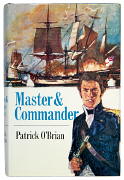
|

|
The continuing popularity of Patrick O'Brian's Jack Aubrey and Steven Maturin historical novels ensured strong interest in Dominic Winter's Modern Firsts auction on 16th December with and near fine copy of the first book in the series, Master and Commander, reaching £500 against a pre-sale estimate of £200 - £300. There was equally strong interest and even stronger bidding for a first edition of Orwell's 1949 classic, 1984, which exceeded the pre-sale estimate by a factor of ten. The hammer fell at £2,050.
Other highlights of the sale included a set of firsts of Tolkien's Lord of the Rings which closed at £3,600; and a complete set of Jonathon Gash's Lovejoy novels - 22 volumes, all firsts, which closed at £700. A surprising number of lots, some featuring the works of authors who usually appeal to collectors such as Agatha Christie, Philip Pullman and Oscar Wilde, failed to find buyers.
The Roald Dahl charity auction held at Christie's, London, on 13th December, raised a little over £84,000 for the Roald Dahl Museum and Story Centre, which will open in Great Missenden in June next year. The auction included a treasure trove for Dahl collectors which included original artwork by Quentin Blake and Gerald Scarfe which sold for £2,800 and £5,000 respectively.
Also included in the auction was a unique collection of photographs of
Dahl and his family, including Dahl in his school uniform in 1925 (sold
for £1,000 against a presale estimate of £750); a charming shot of
Patricia Dahl with the Dahl children under her skirts (sold for £7,500
against an estimate of £1-£2,000) and a photograph of Henry Moore taken
by Dahl himself in 1975 (sold for £2,000).
|
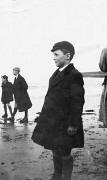
|
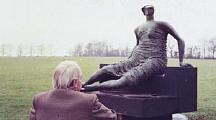
|
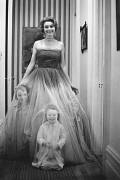
|
|
Dahl
in school
uniform
|
Henry
Moor by
Dahl
|
Patricia
Dahl and
children
|
|
Photos above
courtesy
Christie's Images Ltd, 2004
|
|
|
The Wordsworth Trust
'Weekend Arts and Book Festival'
A residential course of lectures and workshops
organised by the Wordsworth Trust takes place at the
Thistle Hotel 21st-23rd January 2005 on the shores of
the lake at Grasmere, just a hundred yards from Dove
Cottage, the Wordsworth Museum and the Jerwood Centre.
The Festival will be chaired by Dr Robert Woof.
Although the lecturers are experts and connoisseurs,
the aim of the Festival is to reach out to a general
public. There will be special visits to the Wordsworth
Museum and the Wordsworth Library. The full residential
fee of £280 covers accommodation, breakfast, lunch,
dinner, lectures, workshops, surgeries and and access
to the Wordsworth Museum and the Jerwood Centre.
Further details.
|
|
Internet alert leads to
conviction of map thief
Peter Bellwood, a 50 year old landscape gardener from
Colchester in Essex was gaoled for four and a half
years at Swansea Crown Court on 22nd December. He had
confessed to specimen charges of the theft of 50
antique maps valued at £70,000 from the collection of
the National Library of Wales in Aberystwyth, of 105
that the library said were missing, most of which have
not been recovered.
The thefts in Wales were discovered after Danish
authorities said they wanted him in connection with the
theft of 16th and 17th Century maps valued at £100,000
from Danish Royal Library in Copenhagen, releasing onto
the internet closed circuit TV coverage of him caught
in the act of removing them. The Welsh library staff
checked their records, realised that he had visited the
National Library and subsequently found that many of
their rare maps were missing.
It appears that several other European libraries,
including the Royal Library of Stockholm have also
had
visits from Bellwood. The library that initiated the
search for him hopes to recover some of their loss and
extradition proceedings have been started by the Danish
authorities.
|
|
Reading Bookfair Diary
Dates
The 'new' Reading Bookfair will be held on:
-
Sunday 13th February
-
Sunday 8th May
-
Sunday 14th August
-
Sunday 6th November
...with up to 20 exhibitors at The Parish Hall, School
Green (off the B3349 Hyde End Road), Shinfield, (one
mile from Junction 11 of M4, leave on A327 to
Shinfield), 10.00am to 4.00pm, free car parking and
light refreshments.
|
|
Next Month: The feature for
February 2005 by Hessay Books
|
|
|
|
|
|

